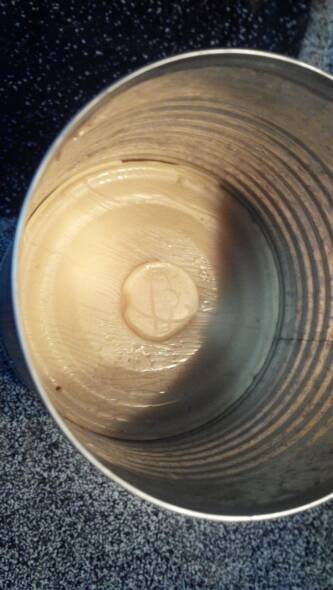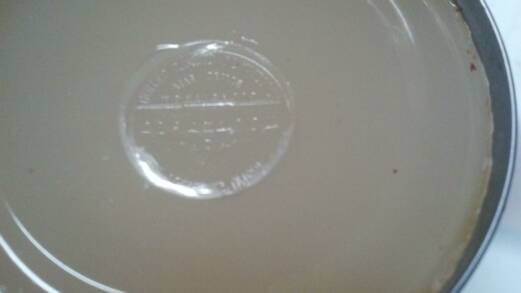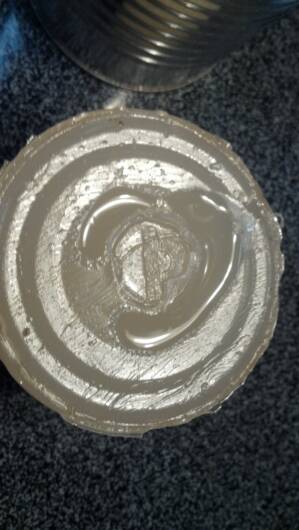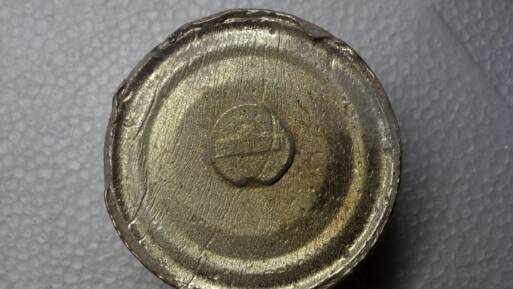
Backyard Foundry E-Zine
Gelatin, Glycerin mold
01-26-2013
I saw a recipe for making a reusable mold material using glycerine and gelatin. I had a hard time finding glycerin locally for a decent price. I did find it at a couple of pharmacies and a craft store but it was about a dollar and ounce. Well, the recipe called for glycerin and denatured alcohol...so I found some skin lotion that had glycerin as the first ingredient and also had alcohol plus a few other things too...so I figured it was worth a try!!
Here is what I found to use.
I heated the lotion up and added the little packets of gelatin. I put one box in and let it set up...then reheated and added another box just to make sure I had enough in it. When it set up, the mix separated out into the gelatin/glycerin on the bottom and a white layer on the top. The white layer was very easy to crack loose and remove. Then, I wiped what was left off of the glycerin and here is what I got:
To test it out, I glued a nickle onto the bottom of a can and then heated the material and poured it into the can. Here is what I got...The nickle wasn't flat on the can so some of the material got under the edge and pulled loose:
Next, I poured wax over the mold...I was worried that the mold material would melt quickly and not work so I let my wax get as cool as possible...it was starting to solidify when I poured it...about 130 degrees F. You can see that a loose edge of the mold material moved over the mold...and the details did get blurred
Here is the glycerin after I pulled it out of the can. It looks like it melted and ran some so I am surprised that the wax turned out as well as it did.
Next, I invested it using 1 part plaster of paris and 1 part sand and burned it out in the kitchen oven for a couple of hours at 550 degrees F. (That is not a high enough temperature if pouring aluminum or brass, but I was using pewter to make this test)
Here is the result:
Conclusions: It does work, but because of its low melting point, it is going to be hard to use with wax. My next test will be to make a pattern using wax...pour the glycerin into that and then use the glycerin as a mold to pour the investment over
Here is the original recipe I got from a member of the alloy avenue forum: It is a great metal casting forum...click on the link to join.
"Re-usable gelatine molding material.
I was looking on the net for a re-usable mold material to try and off set the ridiculous prices of the rubbers and here's one based on a very old standby, gelatin. Yep, the same stuff Jello is made of but with an addition of glycerin to make it a bit more rubbery. It's not a perfect substitute for the rubbers, but it's good for a lot of mold uses.
This material is really simple to make, the components are cheap and it can be made on the stove. But here’s the caveat, follow the instructions exactly. They’re simple but there are no shortcuts, there are no substitutions, and there’s no alternatives. Each batch you make must be made completely by itself, you cannot make it in an existing batch. You can mix batches together after they’re done but not before.
Materials
So here’s the full sized formula; A. 4.5 pounds of gelatin. B. 9 cups of cool water c. 13 cups or 9 pounds of glycerin and 1 oz of denature alcohol. I like mixing it up in 1/3 sized batches. A. 1.5 pounds of gelatin B. 3 cups cool water C. 4 1/3 cups of glycerin, or 1 liter and 1 tablespoon of denatured alcohol. The alcohol acts as a disinfectant for the mix, the glycerin and gelatin are perfect growing mediums for bacteria.
Method
You’ll need two pots, one large soup sized pot for mixing the gelatin and water and then adding the glycerin to. And a suitable sized pot for heating the glycerin.
1. Put the measured glycerin into the pot over low heat. Do not add it to the gelatin unheated.
2. Pour the water into the large pot and add the gelatin gradually. Mix until all the gelatin is in and mixed to a consistent quality. It works best with your hands.
3. Put this pot over low heat and stir until all the gelatin is melted. Then add the heated glycerin and mix again. Remove from the heat and add the alcohol.
And that’s it.
Be careful not to overcook the gel mold material, as it will cause it to become syrupy.
The tear strength can be increased by increasing the thickness of the mold or laying in pieces of fibreglass window screen.
Re-use by simply putting it back into the pot and heating.
Tools can be cleaned by washing with warm water. I use a cheap synthetic brush to brush the gel on to the subject. When the gel hardens in the brush it can be softened with either warm water or by putting it in the pot of warm gel. Use mold release. Very little seems to stick to cool gel."
Squeezed into bowl.




Well, that's all Folks! If you enjoyed it...leave a message on this page in the guestbook so we can all see who has been here!

Please sign my guest book....This is a public guest book, so you can see comments other people left. Only leave as much info as you are comfortable with...location would be nice at least!
I use Homestead for my web site. I have used them for over 20 years and love them. You can get a free trial now...just click on the link below to check it out!
Here is a video of the glycerin product
Update: 01-27-2013: One of the persons on the e-zine gave me some information that can be researched. Here is his note to me:
Dave,
I spent a little time researching glycerin. It is also called glycerol.
By that name I found that "for every 100 pounds of biodiesel produced,
10 pounds of glycerol is produced as a byproduct". In this form it is
not fit for food or cosmetics and it would be prohibitively expensive to
filter and treat it to make it fit for humans. But, aside from some
chemicals and trace elements, it is the same as pharmaceutical glycerin.
It should work just fine for that mold formula.
So, if you contact a biodiesel producer in your area, odds are good you
can get as many pounds as you want for pennies per pound. Heck, a small
producer might just give it to you.
Here is an article that outlines the contaminants in glycerol:
And here is a page that lists bio-fuel equipment dealers in Florida (and
elsewhere):
The dealers can tell you who is currently making biodiesel near you. I
hope that is helpful information.
In addition: Someone at alluy avenue mentioned that there is a product that is used to make molds that has a low melting point...seems like it would work for this. Here is the link: CLICK
Then, I did a quick search for low melting point wax and got this: CLICK It says 120 F which still seems a little hot for this.

